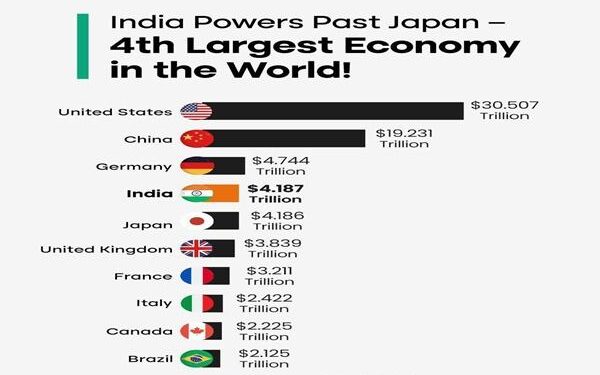India is on a rapid trajectory to emerge as a $10 trillion economy within the next decade, driven by robust domestic growth and expanding global partnerships. According to The Economic Times, the country’s burgeoning economic landscape will significantly benefit from contributions by Gulf Cooperation Council (GCC) countries, which are expected to inject around $0.5 trillion into India’s development. This strategic collaboration underscores the deepening economic ties between India and the GCC, highlighting a new era of investment and trade that is set to bolster India’s ambitions of becoming a global economic powerhouse.
India’s Path to a Ten Trillion Dollar Economy and the Strategic Role of GCC Investments
India’s ambitious journey towards a $10 trillion economy is anchored on robust growth drivers, including digital transformation, infrastructural investments, and manufacturing expansion. The government’s focus on fostering innovation, streamlining regulations, and boosting domestic demand sets a strong foundation for sustained economic acceleration. Amid these efforts, foreign direct investment (FDI) inflows, especially from the Gulf Cooperation Council (GCC) countries, are emerging as a significant game-changer in both scale and strategic importance. Analysts project that GCC investments will contribute approximately $0.5 trillion over the next decade, directly supporting sectors such as energy, real estate, and technology startups.
The GCC’s role transcends capital infusion; it also brings in pivotal expertise and access to global markets. Several key sectors are poised to benefit significantly, including:
- Renewable energy: Collaboration on clean energy projects to meet India’s climate goals.
- Infrastructure: Development of ports, logistics hubs, and smart cities bolstered by GCC funds.
- Technology & innovation: Joint ventures in AI, fintech, and digital services.
| Sector | Projected GCC Investment (USD Billion) | Impact |
|---|---|---|
| Energy (Renewables & Oil) | 200 | Enhanced sustainability & security |
| Infrastructure | 150 | Improved connectivity & urban development |
| Technology & Startups | 100 | Innovation-driven growth |
| Other | 50 | Diversified economic engagement |
Key Sectors Driving Growth and Opportunities for GCC Contributions in India’s Economic Expansion
Several sectors stand out as pivotal engines fueling both India’s ambitious journey toward a $10 trillion economy and the substantial $0.5 trillion contribution projected from the Gulf Cooperation Council (GCC) countries. Energy and infrastructure development remain at the forefront, with GCC investments accelerating renewable energy projects and smart city initiatives. Additionally, technology and digital services have witnessed a surge, leveraging GCC’s capital to enhance India’s startups and IT exports, further integrating the two regions’ economies. The focus on sustainable growth also opens avenues in green technology, electric vehicles, and water management solutions, sectors where the GCC’s expertise and resources have proven invaluable.
Moreover, the manufacturing and consumer goods industries present significant opportunities. Expansion in sectors like pharmaceuticals, textiles, and FMCG aligns with India’s Make in India campaign, inviting GCC partners to co-develop global supply chains. Tourism and hospitality are also evolving as key contributors, strengthened by increased air connectivity and collaborative cultural initiatives that draw GCC visitors. Below is an overview of key sectors and their estimated contribution percentages to the GCC-India economic partnership:
| Sector | Estimated GCC Investment Contribution (%) | Growth Potential (Next 10 Years) |
|---|---|---|
| Energy & Infrastructure | 30% | High |
| Technology & Digital Services | 25% | Very High |
| Manufacturing & Consumer Goods | 20% | Moderate to High |
| Tourism & Hospitality | 15% | Growing |
| Green Technology & Sustainability | 10% | Emerging |
Policy Recommendations to Harness GCC Partnerships for Sustainable and Inclusive Development
Strengthening trade and investment frameworks between India and GCC countries is vital to unlock the envisioned $0.5 trillion contribution. Policymakers should prioritize creating specialized economic zones and streamline regulatory approvals to attract GCC capital into sectors such as renewable energy, technology, and manufacturing. Enhancing bilateral agreements with clear sustainability benchmarks will ensure long-term benefits. Furthermore, fostering public-private partnerships aimed at inclusive development can accelerate job creation, particularly for youth and women, aligning with India’s broader social objectives.
Building resilient supply chains and innovation hubs tailored to the GCC-India partnership can catalyze shared growth. Investment in infrastructure projects along critical corridors should integrate clean energy technologies and digital solutions to promote environmental sustainability and economic inclusion. Below is a strategic framework table outlining priority areas:
| Focus Area | Policy Action | Expected Impact |
|---|---|---|
| Renewable Energy Collaboration | Joint R&D and green finance mechanisms | Reducing carbon footprint & energy security |
| Start-up Ecosystems | Cross-border incubators and funding access | Innovation & employment generation |
| Logistics & Infrastructure | Integrated transport corridors with smart tech | Efficient trade & reduced costs |
| Skills & Capacity Building | Vocational training programs linking GCC investors | Inclusive workforce & social upliftment |
In Retrospect
As India charts its path toward a $10 trillion economy over the next decade, the significant contribution of Global Capability Centers (GCCs), expected to add $0.5 trillion, underscores the evolving dynamics of the country’s growth story. With sustained investments, policy support, and innovation at the core, India is poised to strengthen its position on the global economic map. The collaborative efforts between government, industry, and the GCC ecosystem will remain crucial in driving this transformation, heralding a new era of prosperity and global competitiveness for the nation.






























